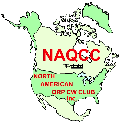
 | NAQCC News |
| Sep 11, 2010 | NAQCC Web Site | Issue #126 | |
|---|---|---|---|
|
In this issue: 1. September Sprint. 2. August Challenge Results 3. General Club News 3a. European Chapter News 4. Elmer Project 5. CW Cartoon of the Month 6. Member Spotlight 7. News Items and Articles by Our Members |
| 1. SEPTEMBER SPRINT: Our September sprint is this coming Wednesday evening local time which is Thursday 0030-0230Z time. It should prove interesting to see if we can continue our run of record sprints with the changing of the seasons. We may lose some of the effectiveness of 20 meters with the shorter period of daylight. Also 40 meters will probably go to long skip by the time of the sprint. Hopefully 80 meters will take up the slack if the summer QRN has subsided. At any rate, I'll be in there trying my best to take advantage of what the bands have to offer. I hope you will be also. Our new Call Area Divisions seem to be encouraging more folks to participate. Effectively competing against others in your own call area makes the sprint more interesting, I believe. That way you don't have to compete against those located in an area that is more geographically favorable for making contacts. Making the playing field level is one of the goals of our sprints. We want as many folks as possible to experience the thrill of winning something in a contest or sprint. That's something a lot of us have no chance of doing when we're up against the big (almost) professional contest stations. Another thing that seems to be encouraging participation are the reminders I send out the morning of the sprint to all members who are on our mailing list. If you don't get one of the reminders, then there is something wrong with your email address as we have it here. Please let us know so we can update it. Email addresses seem to change as often as the weather. Yet another encouragement is our special First-Timer certificate that goes to the highest scoring participant who never before submitted a log for one of our sprints. August's winner was N1FJ who emailed us saying how thrilled he was with the certificate. There is also the prize of custom made (by Gregg WB8LZG) bug/paddle handles or straight key knobs that goes to the one chosen in a random drawing among ALL participants who submit a log regardless of score. The August winner was KD4UKW who similarly was delighted with his prize. This prize giveaway will continue through November. If you are entering one of our sprints for the first time, we welcome you and hope you will be a regular participant from now on. Last month we welcomed another large bunch of new participants - 23!! Remember this is only a brief overview of the coming sprint. Be sure to read and understand the full general sprint rules and any specific rules for this month's sprints here. 2. AUGUST CHALLENGE RESULTS: The challenge submission deadline is still a few hours away as this newsletter is being posted. If any last minute entries come in, we'll update the results in the next newsletter and of course on the challenge page. As of now, we've had 9 entries with KU4A and KB1PBA both getting certificates with their 72 and 71 points respectively. This completes 3 years of having a Poker Challenge, and we have enough data now to evaluate how the odds of making hands with calls compares with making hands with actual cards. Let's take a look. We've had 282 hands made with the distribution and approximate odds computed as follows: Hand Nr Odds RF - 0 ? SF - 1 281-1 4K - 17 17-1 FH - 14 19-1 FL - 4 70-1 ST - 3 93-1 3K - 42 6-1 2P - 44 5-1 1P - 118 1-1 0P - 39 6-1Thus we are re-evaluating our points system as follows. We'll keep a no pair hand as the lowest point value even though it is harder to make than 3K, 2P, and 1P hands. RF-10 SF- 9 ST- 8 FL- 7 FH- 6 4K- 5 3K- 4 2P- 3 1P- 2 0P- 1 Full Challenge info here. 3. GENERAL CLUB NEWS: Here's a listing of those of you who have signed up as ops. You'll notice a couple call areas have only one op. We like to have at least 2 or 3 from each area so we can get as much "air time" as possible for each of our N#A calls. So hopefully we will still have more of you volunteer, especially in those areas. N1A - W1OH, N1LU N2A - KA2KGP, N2COD N3A - K3WWP, WY3H, KC2EGL, WA3HIC, AF3Z N4A - K3RLL, AJ4SB, AA4W, K2UFT, K0NWT, AD4S, KD4UKW N5A - W5YDM, K5JYD, KC5FM N6A - K6CSL N7A - WY7N N8A - W8RIT N9A - W9BOK, W9DLN N0A - KD0VThere's no limit on the number of ops for each station. You just have to work out a schedule among yourselves in each call area to avoid conflicts in operating times and frequencies. Remember basically all you need to do is to operate as you normally do, but use a N#A call instead of your own. So anyone from raw newcomers to seasoned veteran can do the job equally well. More info upcoming in future newsletters, as well as here. 3a. EUROPEAN CHAPTER NEWS FROM MATT MW3YMY: The rules for the European sprints can be found here: http://www.naqcc-eu.org/SprintRules.pdf They do differ very slightly from the rules for the existing NAQCC sprints, so it might be a good idea to print off a copy and keep them by the key during the sprint, as well as reading them before the sprint commences. The frequency ranges are very tight, so that it will be easy for us all to find each other: 80M - 3,555kHz-3,560kHz 40M - 7,030kHz-7,035kHz 20M - 14,060kHz-14,065kHz The rules state that deviation is permitted, and this is the case if QRM dictates. Please try to stay as close as possible to them. The call will be CQ EU. We had some trouble in deciding exactly what the call would be - neither the generic CQ or CQ TEST, really covers it like CQ NA does for the existing sprints, so we decided on this. Any ideas would be gratefully received for future sprints. In order that we can get the results out as soon as possible, the deadline for log submission is very soon after the sprint. All logs must be received within 72 hours of the end of the sprint. However, this should not be a problem using the GenLog/Autologger way of submitting a log, as the whole process is just a 5 minute job at the end of the sprint. Instructions for using the GenLog/Autologger combination aimed at European members can be found here: http://www.naqcc-eu.org/LoggingInstructions.pdf Hopefully, all other details/instructions are included in the rules. This first sprint will be a historic moment for the NAQCC and marks the first major event for the European Chapter, something on which we can build a great future. There will most likely be some glitches, mainly with GenLog which is not quite fully configured for the European Sprints yet, but this first sprint will highlight them and they'll all be ironed out for October! Essentially, just follow the instructions for using GenLog and the Autologger, and we'll clean up whatever comes out and calculate your score accurately, even if GenLog outputs the wrong number of points for a particular QSO. Finally, I should like to introduce the website for the chapter, http://www.naqcc-eu.org/. At the moment its only purpose is to host the autologger and other documents relating to the Sprints, but over the next month it will turn into a very comprehensive site. Watch this space. I'd be more than happy to answer any questions, even during the sprint if necessary. The address, as ever, is 4. THE NAQCC ELMER PROJECT: 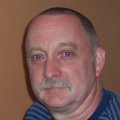  The Elmer project is co-ordinated by Karl N3IJR (L) and Ron K5DUZ. If you are interested in helping out or need help with any CW and/or QRP matters contact: K5DUZ - N3IJR - Elmer's tip: Many folks are blaming the sunspots for the poor performance on the bands. Well that's true to a certain extent. However the bands are a lot better than those folks believe even with the current low sunspots. The real reason the bands sound empty is that folks believe they are dead. They take a quick tune across a band, hear nothing, and shut down. Now if everyone does that, it's certain the bands will sound dead. Someone MUST initiate things by calling CQ. For example, I've tuned across 30 meters and found no stations there. I didn't give up though. I called CQ and often within a couple minutes gotten an answer and had a nice solid long rag chew. You've got to transmit to 'open up' a band. If you don't believe that, just listen to the bands (even all the way up to 10 meters) Many more examples of good operating practices as well as seeing what can be done on 'dead bands' is found on the Elmer Project page of the web site and especially on K3WWP's Web Site NAQCC QRS Net Report
Date(UTC) NCS Participants 8/30/10 WY3H 5 - WY3H, K3WWP, K1IEE, N4FI, N1LU 9/6/10 WY3H 5 - WY3H, K3WWP, K1IEE, K6BFA, N1LUFrom Tom WY3H - We had a great turn out for last week's Sunday evening net. Our net frequency is 7.114.5 and the net begins at 0030 Z (8:30 p.m. EDT). The net is quite informal and everyone is invited to check in. If anyone is not familiar with net Q-signals that's OK too (we really don't use them much). The NAQCC would also like members to step up to volunteer as Net Control ops. You don't have to commit to every week. What we are asking members is to try being an NCS just once. Please contact Tom, WY3H at: We need YOU to make our Elmer project work. If you need help with any ham radio matter or are willing to help others with your expertise, please contact our Elmer directors: K5DUZ - N3IJR - WY3H - Also see Elmer Project on the web site. 4a. CW CARTOON OF THE MONTH: 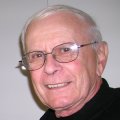 Let's take a comedy and/or nostalgia break now courtesy of Dick Sylvan W9CBT. Dick has been a long-time QRP/CW operator. One of his many talents is being a cartoon artist, and he is supplying a cartoon each month for the newsletter. The NAQCC is very honored to be one of just two organizations to feature Dick's cartoons. In addition to our newsletter, Dick's cartoons appear monthly in The K9YA Telegraph, an on-line only Ham Radio E-zine where he is the staff cartoonist. Dick has also authored a book entitled "Hi Hi - A Collection of Ham Radio Cartoons" available via his web site. A new cartoon will be appearing in each of our even-numbered newsletters. 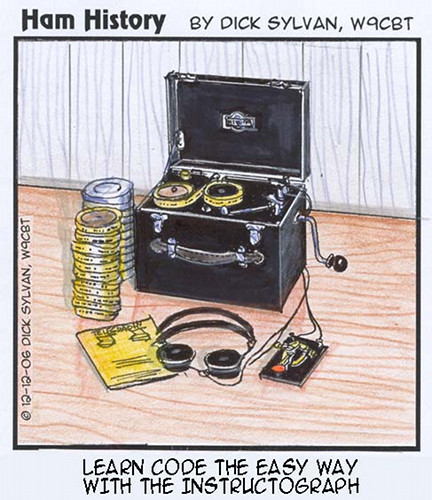 7. MEMBER SPOTLIGHT:  This section is managed by Paul N8XMS and any questions about it should go to Tim Davisson KD8GZ #1262 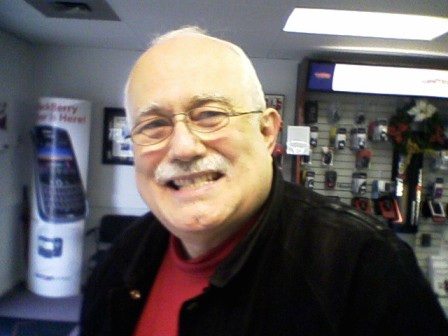 CW was something that gave me fits for about 20 years...back in my shortwave listener/AM DXer days of the early 60's+. I tried and tried to learn CW...but just couldn't. In late 1980 I finally became determined to learn the code and get my ham license. I studied and studied, and in early '81 I got my tech license and within a year, by some miracle, I went extra. Did some CW...lots of SSB...then by late '87 grew discouraged with "only" having 300 watts on SSB & a 60-foot end-fed wire antenna. Not enough money for a big 1kw rig...lot too small and a "NO TOWER" XYL...I dropped out of the hobby totally til June, 2005. My wife and I moved across town in 1995, and now live on 4 acres. In early 2005 I met a couple local hams...one guy (AB8AV) a big CW lover. In the early summer of 2005 I went back on the air, and I've been 100% CW since (except rare 2M SSB)...and I'm having a great time! In June of 2005 I bought a new Icom bare-bones IC-718 with DSP but no other filters (darn!). And, my antenna is nothing great: folded dipole barely 20 feet off the ground (180'x90'). And, I use an old straight key and a 30-year-old Ten Tec tuner. In early 2006 I learned about QRP. And, that's what I do about 70% of the time. My "QRO" output is about 30 watts...but, that's rare. And, it's all CW! Despite lousy propagation these past 2 or 3 years...I've had some great times on CW QRP...am just Delaware & Hawaii worked from CW QRP WAS..and have worked about 40 countries in every continent except Asia (haven't really tried to DX that much!). And, I love traditional QSL cards. I can copy just over 25WPM...but am most comfortable working 13-16WPM. I don't really like contests, and unfortunately have never been good at building or repairing equipment. And, I'm on the air only a couple hours a week, tops. My point? Even for a guy with limited electronic skills, not that many hours per week on the air, not a code-sending speed-demon, and very a very simple station...I've worked all over the country, and all over the world in the depth of a long sunspot minimum. All you really need is basic equipment, and a knowledge of propagation (my years of SWLing helped there!). Thanks to NAQCC and the other CW clubs that keep promoting the use of CW...especially CW QRP. CW QRP...what a great hobby. Let's keep spreading the word! Best 72's, Tim, KD8GZ 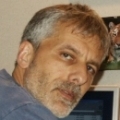 7. NEWS ITEMS AND ARTICLES BY OUR MEMBERS: This section is a forum for you to tell other members what you've been up to on the ham bands or to submit an article dealing with some aspect of CW and QRP operation or equipment. Send your news items and articles to our news editor Paul KD2MX at
7. NEWS ITEMS AND ARTICLES BY OUR MEMBERS: This section is a forum for you to tell other members what you've been up to on the ham bands or to submit an article dealing with some aspect of CW and QRP operation or equipment. Send your news items and articles to our news editor Paul KD2MX at DISCLAIMER: Any views expressed in this section are those of the member submitting them, and may or may not be those of the NAQCC or its officers. Among the other QSO's, it was nice to work Rick AA4W on two bands. He was using a mere 300 mW, and a PA to FL QSO with that power on 40 meters in mid-afternoon is not all that common. Don worked an IK5 station for the only DX QSO. I don't have Mike or Don's logs here, but I remember Don worked one of our most dedicated members Dick K1IEE, and he also worked a long time friend of mine from the 60's Chuck W8LQ who was W2WOE back then. There's more about the operation in the Diary on my web site including pictures. I was tuning around 17 meters which was open, and heard IK5VLP, Alex, in Florence Italy, calling CQ. To my surprise, nobody went back to him. So I figured I'd throw my seven watts at him, and see if he could hear me. He did, and, unlike most DX contacts who only want to exchange signal reports, he wanted to chat. So we chatted for at least 10 minutes before the QRM got too bad. Alex was 6217.3 miles from Marina Del Rey, CA, according to QRZ.com. Not too bad for low power and a poor antenna. I was one happy ham. The simple approach turned out to be stuffing 8 AA's in the case. But that would require making it larger. What would be the trade off? What would be the added weight? The solution I came up with added only four ounces to the fully loaded KX1. Here is what the modified KX1 looks like. With four bands, tuner and 8 AA's now weighs in at 16 ounces. 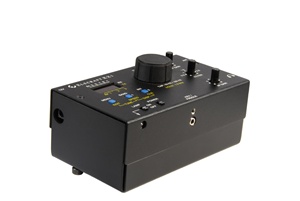 The new bottom case requires four bends, after some band-saw, drilling and rat tail file work. To provide space in the bottom of the unit you just lengthen the bottom by 0.80 inch to miss the crystals and the tuner. The original design uses two battery holders of three each and staggers them around the crystal cases and tuner. By making the case longer you can switch to two packs of four. You purchase a white plug with leads from Elecraft or another source, get two four-pack AA holders, build your case bottom, purchase two one-inch hex spacers and shorten them to 0.8 inch and you are ready to go. 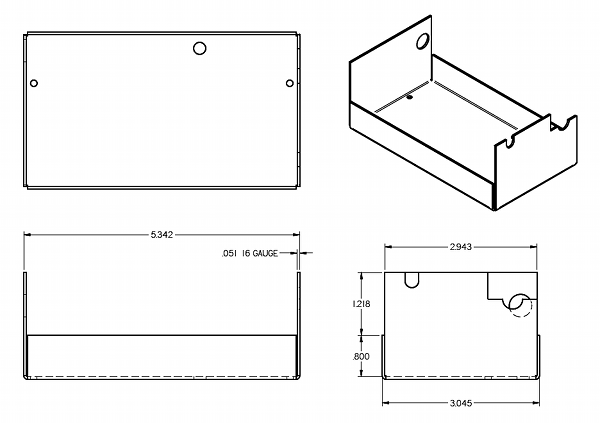 The great thing about 15 gauge aluminum is that one can bend it with a vise and some scraps of oak. Print the drawing (below) full scale and layout your work with a metal scribe on the aluminum. (NOTE: Click the drawing to open a full scale drawing in another browser window. If printing it out from that window does not work or give you the exact size, we suggest you contact N0EVH directly for further help - KD2MX/K3WWP) Then do your hacksaw, drilling and filing to get the shape correct. When you make your bends start with the two end pieces which are longer. Then bend the short ones. For the two short ones you will need to cut your oak to fit just inside the case and clamp it in your vise. Aluminum is so nice to work with especially in 15 gauge. Don't worry about scratches....as you are going to paint it flat black when complete! Below is a photo of the unit taken apart so you can see the hex stand offs. Converting back to the original design takes all of one minute. If your tuner tends to work loose you can cut a piece of foam the correct size to wedge between it and the AA batteries. 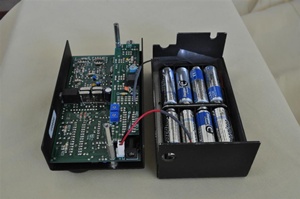 Hope to hear you from the trail or picnic bench sometime. 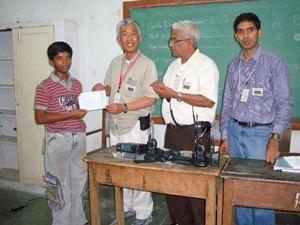
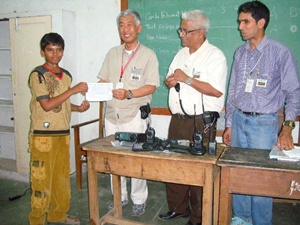 Manu M Pillai and Manish M Pillai receiving CSCE (General) from Kawabe, AB2S 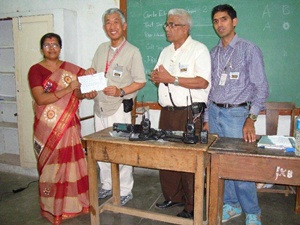
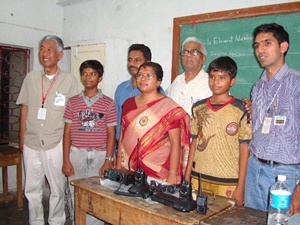 Nisha M Mohan, VU2NIS receiving CSCE (General) from Kawabe, AB2S and Manu M Pillai, Madhu Mohan S, Nisha M Mohan and Manish M Pillai, the all Ham family along with VEs There is never a charge for lookers or sellers but bring your tailgate or a table. Lots of socializing is okay too. Brats, dogs and sodas will be available as always for those wishing to dine al fresco while enjoying a fine sunset. Portable QRP stations and antennas have already been promised but please bring your portable rigs and/or antennas too. First comers get the best spots. A pick-up DX contest might just happen again this year if the sunspot gods get the lead out! For additional information contact Dave Gauding, NF0R at 314 878-1038 or email dgauding@sbcglobal.net. We always have a fine turnout for our annual tailgate meeting. Guests are most welcome and appreciated - along with your gear-for-sale and your cold hard cash! As usual, you will find commercial QRP rigs and homebrew equipment on display as well as many old and new friends ready to talk amateur radio and engage in a little show and tell. Here's hoping you can join us again this year or for the first time. - ST. LOUIS QRP SOCIETY |
Club email address - The publication of our next newsletter will be announced via email to all members for whom we have a valid email address unless you specifically have unsubscribed from the email. Past on-line newsletters beginning with issue #042 are now archived on the site. So if you missed seeing any past issues, you can check them out in the archives. Unless otherwise credited, all items are written by K3WWP. If you came directly to this newsletter, we invite you now to browse the NAQCC Web Site. |